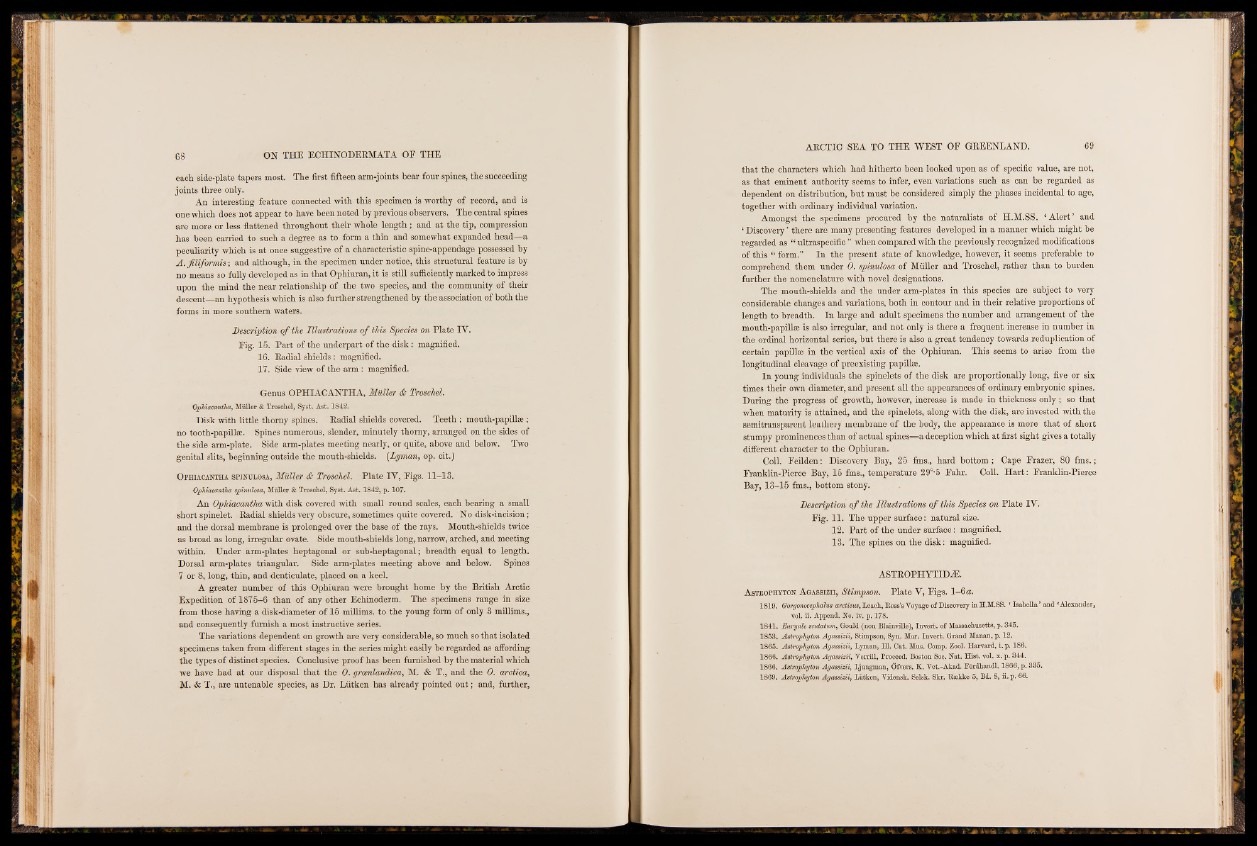
each side-plate tapers most. The first fifteen arm-joints bear four spines, the succeeding
joints three only.
An interesting feature connected with this specimen is worthy of record, and is
one which does not appear to have been noted by previous observers. The central spines
are more or less flattened throughout their whole length; and at the tip, compression
has been carried to such a degree as to form a thin and somewhat expanded head—a
peculiarity which is at once suggestive of a characteristic spine-appendage possessed by
A. fliformis; and although, in the specimen under notice, this structural feature is by
no means so fully developed as in that Ophiuran, it is still sufficiently marked to impress
upon the mind the near relationship of the two species, and the community of their
descent—an hypothesis which is also further strengthened by the association of both the
forms in more southern waters.
Description o f the Illustrations o f this Species on Plate IV.
Fig. 15. Part of the underpart of the disk: magnified,
16. Badial shields : magnified.
17. Side view of the arm: magnified.
Genus OPHIACANTHA, Muller & Troschel.
Ophiacantha, Miiller & Troschel, Syst. Asfc. 1842.
Disk with little thorny spines. Radial shields covered. Teeth ; mouth-papillee;
no tooth-papillae. Spines numerous, slender, minutely thorny, arranged on the sides of
the side arm-plate. Side arm-plates meeting nearly, or quite, above and below. Two
genital glits, beginning outside the mouth-shields. {Lyman, op. cit.)
Ophiacantha spinulosa, Muller & Troschel. Plate IV, Figs. 11-13.
Ophiacantha spinulosa, Muller & Troschel, Syst. Asfc. 1842, p. 107.
An Ophiacantha with disk covered with small round scales, each bearing a small
short spinelet. Radial shields very obscure, sometimes quite covered. No disk-incision;
and the dorsal membrane is prolonged over the base of the rays. Mouth-shields twice
as broad as long, irregular ovate. Side mouth-shields long, narrow, arched, and meeting
within. Under arm-plates heptagonal or sub-heptagonal; breadth equal to length.
Dorsal arm-plates triangular. Side arm-plates meeting above and below. Spines
7 or 8, long, thin, and denticulate, placed on a keel.
A greater number of this Ophiuran were brought home by the British Arctic
Expedition of 1875-6 than of any other Echinoderm. The specimens range in size
from those having a disk-diameter of 15 millims. to the young form of only 3 millims.,
and consequently furnish a most instructive series.
The variations dependent on growth are very considerable, so much so that isolated
specimens taken from different stages in the series might easily be regarded as affording
the types of distinct species. Conclusive proof has been furnished by the material which
we have had at our disposal that the 0. grcenlandica, M. & T., and the 0. arctica,
M. & T., are untenable species, as Dr. Liitken has already pointed out; and, further,
that the characters which had hitherto been looked upon as of specific value, are not,
as that eminent authority seems to infer, even variations such as can be regarded as
dependent on distribution, but must be considered simply the phases incidental to age,
together with ordinary individual variation.
Amongst the specimens procured by the naturalists of H.M.SS. ‘Alert’ and
c Discovery ’ there are many presenting features developed in a manner which might be
regarded as “ ultraspecific ” when compared with the previously recognized modifications
of this “ form.” In the present state of knowledge, however, it seems preferable to
comprehend them under 0. spinulosa of Muller and Troschel, rather than to burden
further the nomenclature with novel designations.
The mouth-shields and the under arm-plates in this species are subject to very
considerable changes and variations, both in contour and in their relative proportions of
length to breadth. In large and adult specimens the number and arrangement of the
mouth-papillee is also irregular, and not only is there a frequent increase in number in
the ordinal horizontal series, but there is also a great tendency towards reduplication of
certain papillae in the vertical axis of the Ophiuran. This seems to arise from the
longitudinal cleavage of preexisting papillae.
In young individuals the spinelets of the disk are proportionally long, five or six
times their own diameter, and present all the appearances of ordinary embryonic spines.
During the progress of growth, however, increase is made in thickness only; so that
when maturity is attained, and the spinelets, along with the disk, are invested with the
semitransparent leathery membrane of the body, the appearance is more that of short
stumpy prominences than of actual spines—a deception which at first sight gives a totally
different character to the Ophiuran.
Coll. Feilden; Discovery Bay, 25 fms., hard bottom; Cape Frazer, 80 fms.;
Franklin-Pierce Bay, 15 fms., temperature 29°*5 Fahr. Coll. H a rt: Franklin-Pierce
Bay, 13-15 fms., bottom stony.
Description o f the Illustrations o f this Species on Plate IV.
Fig. 11. The upper surface: natural size.
12. Part of the under surface: magnified.
13. The spines on the disk: magnified.
ASTROPHYTIDAE.
A strophyton A ga ssizii, Stimpson. Plate Y, Figs. 1-6«.
1819. Gorgonocephalus arcticus, Leach, Boss’s Yoyage of Discovery in H.M.SS. * Isabella ’ and ‘Alexander,
vol. ii. Append. No. iv. p. 178.
1841. Ewryale scutatmn, Gould (non Blainville), Invert, of Massachusetts, p. 345.
1853. Astrophyton Agassizii, Stimpson, Syn. Mar. Invert. Grand Manan, p. 12.
1865. Astrophyton Agassizii, Lyman, 111. Cat. Mus. Comp. Zool. Harvard, i. p. 186.
1866. Astrophyton Agassizii, Yerrill, Proceed. Boston Soo. Nat. Hist. vol. x. p. 344.
1866. Astrophyton Agassizii, Ljungman, Ofvers. EL. Yet.-Akad. Fordhandl. 1866, p. 335.
1869. Astrophyton Agassizii, Liitken; Yidensk. Selsk. Skr. Bsekke 5, Bd. 8, ii. p. 66.